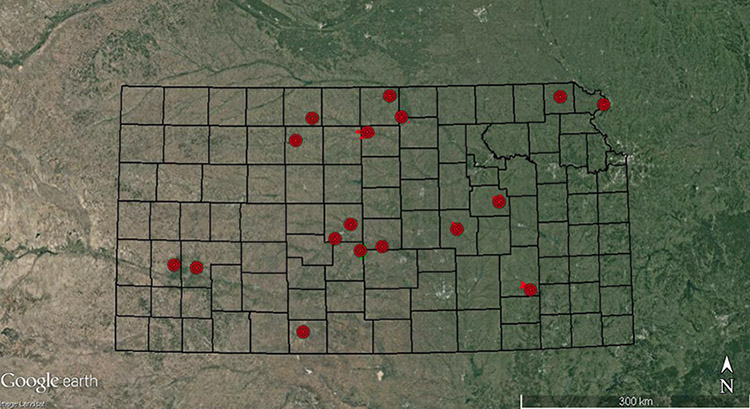Occurrence and Prediction of Avian Disease Outbreaks in Kansas
 Investigators:
Investigators:
Thomas Becker
Project Supervisor:
Dr. David Haukos
Dr. Peg McBee
Funding:
Kansas Department of Wildlife, Parks, and Tourism
U.S. Fish and Wildlife Service
Cooperators:
Shane Hesting
Dr. Tom Roffe
Location:
Throughout Kansas
Completion:
July 2016
Status:
Completed
Objectives:
(1) Compile all known records of avian disease outbreaks in Kansas.
(2) Associate each record with available environmental data (e.g., precipitation index, temperature) and, if possible, estimated population at risk during each outbreak.
(3) Create a historical data base and a web-based reporting form for avian disease outbreaks in Kansas.
(4) Construct predictive models for environmental conditions that may support a disease outbreak.
Progress and Results:
There is a wide variety of diseases that affect wild migratory birds. Occurrence, causes, and impacts of disease outbreaks in wild bird populations are rarely studied beyond documentation of large epizootic events. Interfaces among wildlife, livestock, and humans are rapidly developing closer together. Global interests in avian diseases increased around 1990 as a result of the prevalence of zoonosis and potential threat to domestic livestock. A central disease reporting protocol does not exist in many states, which has led to a lack of available historical knowledge of disease occurrence that could be used to predict and manage future outbreaks. Due to changes of abundance and distribution of the migrant population of Ross's goose (Chen rossii) and Snow goose (C. caerulescens), geese are increasing their residence time in Kansas potentially increasing risk of disease outbreaks. We compiled historic records of avian disease events in Kansas from 1967-2014 establishing a Kansas disease outbreak database and related the frequency of events with increased waterfowl populations from 1970-2014. We found 32 reports spanning 16 counties consisting of the diseases avian cholera, avian botulism, aspergillosis, renal coccidiosis, west Nile, aflatoxicosis, and mycotoxicosis. Using a retrospective survey, we found there was a significant relationship between population densities of light geese in Kansas during the Mid-Winter Waterfowl Inventory and occurrence of avian cholera. Efforts to increase the understanding of relationships between disease outbreaks and host species will improve management of future disease outbreaks. Factors known to cause avian disease (e.g., environmental, species, and individual) assist in disease identification and disease management course of action. Actions taken are predetermined in a disease management plan developed at the state and station level. Surveillance and monitoring schemes are developed within these plans build on the centralized disease database and to promote future disease understanding.
Products:
Thesis:
Becker, T.A. (M.S. 2016; advisor Haukos). Retrospective review of wild waterfowl diseases in Kansas. M.S. Thesis, Kansas State University.
Presentations:
Becker, Thomas. 2016. A Retrospective Surveillance Study of Avian Disease Outbreaks in Kansas. Kansas Natural Resources Conference, Wichita, KS.
Becker, T., P. McBee, and D. Haukos. 2015. Occurrence and predictions of avian disease outbreaks in Kansas. Annual meeting of the Central Mountains and Plains Section of The Wildlife Society, Manhattan, Kansas.
Becker, T., P. McBee, and D. Haukos. 2015. Occurrence and prediction of avian disease outbreaks in Kansas. Joint meeting of American Ornithologists' Union and Cooper Ornithological Society, Norman, OK.